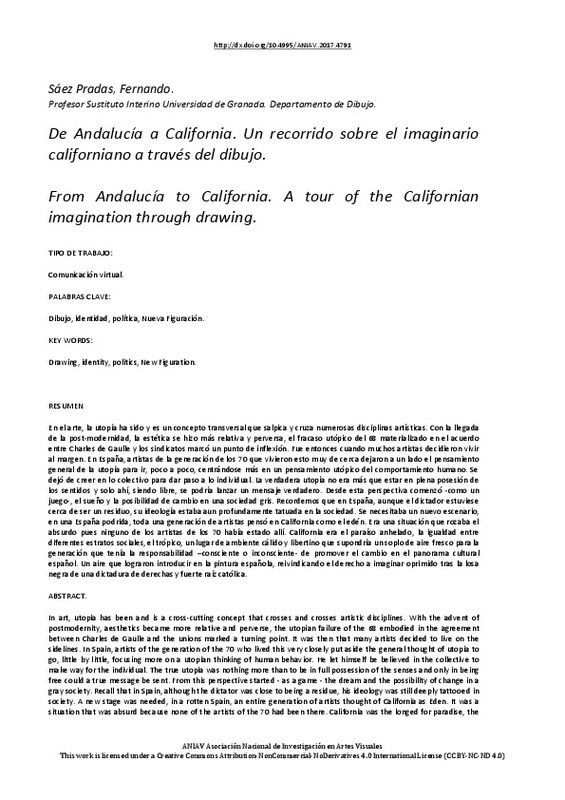JavaScript is disabled for your browser. Some features of this site may not work without it.
Buscar en RiuNet
Listar
Mi cuenta
Estadísticas
Ayuda RiuNet
Admin. UPV
De Andalucía a California. Un recorrido sobre el imaginario californiano a través el dibujo
Mostrar el registro sencillo del ítem
Ficheros en el ítem
| dc.contributor.author | Sáez Pradas, Fernando
|
es_ES |
| dc.date.accessioned | 2018-09-03T08:43:40Z | |
| dc.date.available | 2018-09-03T08:43:40Z | |
| dc.date.issued | 2017-10-23 | |
| dc.identifier.isbn | 9788490485736 | |
| dc.identifier.uri | http://hdl.handle.net/10251/106447 | |
| dc.description.abstract | [EN] In art, utopia has been and is a cross\cutting concept that crosses and crosses artistic disciplines. With the advent of postmodernity, aesthetics became more relative and perverse, the utopian failure of the 68 embodied in the agreement between Charles de Gaulle and the unions marked a turning point. It was then that many artists decided to live on the sidelines. In Spain, artists of the generation of the 70 who lived this very closely put aside the general thought of utopia to go, little by little, focusing more on a utopian thinking of human behavior. He let himself be believed in the collective to make way for the individual. The true utopia was nothing more than to be in full possession of the senses and only in being free could a true message be sent. From this perspective started \ as a game \ the dream and the possibility of change in a gray society. Recall that in Spain, although the dictator was close to being a residue, his ideology was still deeply tattooed in society. A new stage was needed, in a rotten Spain, an entire generation of artists thought of California as Eden. It was a situation that was absurd because none of the artists of the 70 had been there. California was the longed for paradise, the equality between different social strata, the tropics, a place of warm and libertine atmosphere that would suppose a breath of fresh air for the generation that had the responsibility \ conscious or unconscious \ to promote the change in the cultural panorama An air that introduces in the Spanish painting, claiming the right to an imaginary oppressed after the black stone of a dictatorship of right and strong Catholic root. | es_ES |
| dc.description.abstract | [ES] En el arte, la utopía ha sido y es un concepto transversal que salpica y cruza numerosas disciplinas artísticas. Con la llegada de la post-modernidad, la estética se hizo más relativa y perversa, el fracaso utópico del 68 materializado en el acuerdo entre Charles de Gaulle y los sindicatos marcó un punto de inflexión. Fue entonces cuando muchos artistas decidieron vivir al margen. En España, artistas de la generación de los 70 que vivieron esto muy de cerca dejaron a un lado el pensamiento general de la utopía para ir, poco a poco, centrándose más en un pensamiento utópico del comportamiento humano. Se dejó de creer en lo colectivo para dar paso a lo individual. La verdadera utopía no era más que estar en plena posesión de los sentidos y solo ahí, siendo libre, se podría lanzar un mensaje verdadero. Desde esta perspectiva comenzó -como un juego-, el sueño y la posibilidad de cambio en una sociedad gris. Recordemos que en España, aunque el dictador estuviese cerca de ser un residuo, su ideología estaba aun profundamente tatuada en la sociedad. Se necesitaba un nuevo escenario, en una España podrida, toda una generación de artistas pensó en California como el edén. Era una situación que rozaba el absurdo pues ninguno de los artistas de los 70 había estado allí. California era el paraíso anhelado, la igualdad entre diferentes estratos sociales, el trópico, un lugar de ambiente cálido y libertino que supondría un soplo de aire fresco para la generación que tenía la responsabilidad –consciente o inconsciente- de promover el cambio en el panorama cultural español. Un aire que lograron introducir en la pintura española, reivindicando el derecho a imaginar oprimido tras la losa negra de una dictadura de derechas y fuerte raíz católica. | es_ES |
| dc.format.extent | 4 | es_ES |
| dc.language | Español | es_ES |
| dc.publisher | Editorial Universitat Politècnica de València | es_ES |
| dc.relation.ispartof | Glocal [codificar, mediar, transformar, vivir] III Congreso Internacional de Investigación en Artes Visuales | es_ES |
| dc.rights | Reconocimiento - No comercial - Sin obra derivada (by-nc-nd) | es_ES |
| dc.subject | Dibujo | es_ES |
| dc.subject | Identidad | es_ES |
| dc.subject | Política | es_ES |
| dc.subject | Nueva figuración | es_ES |
| dc.subject | Drawing | es_ES |
| dc.subject | Identity | es_ES |
| dc.subject | Politics | es_ES |
| dc.subject | New figuration | es_ES |
| dc.title | De Andalucía a California. Un recorrido sobre el imaginario californiano a través el dibujo | es_ES |
| dc.title.alternative | From Andalucía to California. A tour of the Californian imagination through drawing | es_ES |
| dc.type | Capítulo de libro | es_ES |
| dc.type | Comunicación en congreso | es_ES |
| dc.identifier.doi | 10.4995/ANIAV.2017.4791 | |
| dc.rights.accessRights | Abierto | es_ES |
| dc.description.bibliographicCitation | Sáez Pradas, F. (2017). De Andalucía a California. Un recorrido sobre el imaginario californiano a través el dibujo. En Glocal [codificar, mediar, transformar, vivir] III Congreso Internacional de Investigación en Artes Visuales. Editorial Universitat Politècnica de València. 881-884. https://doi.org/10.4995/ANIAV.2017.4791 | es_ES |
| dc.description.accrualMethod | OCS | es_ES |
| dc.relation.conferencename | III Congreso Internacional de Investigación en Artes Visuales :: ANIAV 2017 :: GLOCAL | es_ES |
| dc.relation.conferencedate | Julio 06-07,2017 | es_ES |
| dc.relation.conferenceplace | Valencia, Spain | es_ES |
| dc.relation.publisherversion | http://ocs.editorial.upv.es/index.php/ANIAV/ANIAV2017/paper/view/4791 | es_ES |
| dc.description.upvformatpinicio | 881 | es_ES |
| dc.description.upvformatpfin | 884 | es_ES |
| dc.type.version | info:eu-repo/semantics/publishedVersion | es_ES |
| dc.relation.pasarela | OCS\4791 | es_ES |








